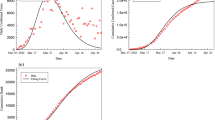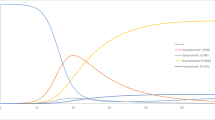Abstract
The hypothesis of a latent period of development of the first wave of COVID-19 in St. Petersburg is verified. According to this hypothesis, the appearance of the first patient was preceded by the latent formation of a local variant of the pathogen, caused by the introduction of the pathogen from outside and that occurred asymptomatically in a number of individuals. A mathematical model with two developmental branches, asymptomatic and clinically manifested, is proposed. The possibility of exacerbation of the asymptomatic form or its termination is considered. Other features of the model include accounting for asymptomatic forms, mild and severe forms of the disease, and a decline in the population’s immunity due to the genetic drift of the pathogen. A technique for sequential identification of the considered model in conditions of a shortage of data is proposed. It is demonstrated that verification of the mathematical model requires a sufficiently large number of asymptomatic individuals at the time the first patient was discovered, which is an argument in favor of the validity of the hypothesis.



Similar content being viewed by others
Explore related subjects
Discover the latest articles and news from researchers in related subjects, suggested using machine learning.REFERENCES
A. J. Kucharski, T. W. Russell, C. Diamond, et al., “Early dynamics of transmission and control of COVID-19: a mathematical modelling study,” Lancet Infect. Dis. 20, 553–558 (2020). https://doi.org/10.1016/S1473-3099(20)30144-4
L. Pribylová and V. Hajnova, “SEIAR model with asymptomatic cohort and consequences to efficiency of quarantine government measures in COVID-19 epidemic,” arXiv preprint arXiv:2004.02601 (2020). https://doi.org/10.48550/arXiv.2004.02601
G. Gaeta, “A simple SIR model with a large set of asymptomatic infectives,” Math. Eng. 3 (2), 1–39 (2021). https://doi.org/10.3934/mine.2021013
G. Giordano, F. Blanchini, R. Bruno, et al., “Modelling the COVID-19 epidemic and implementation of population-wide interventions in Italy,” Nat. Med. 26, 855–860 (2020). https://doi.org/10.1038/s41591-020-0883-7
H.-Y. Cheng, S.-W. Jian, D.-P. Liu, T.-C. Ng, W.-T. Huang, H.-H. Lin, et al., “Contact tracing assessment of COVID-19 transmission dynamics in Taiwan and risk at different exposure periods before and after symptom onset,” JAMA Intern. Med. 180, 1156–1163 (2020). https://doi.org/10.1001/jamainternmed.2020.2020
V. D. Belyakov, D. B. Golubev, G. D. Kaminskii, and V. V. Tets, Self-Regulation of Parasitic Systems: Molecular Genetic Mechanisms (Meditsina, Leningrad, 1987) [in Russian].
I. V. Feldblium, S. O. Golognova, and V. V. Semerikov, “The level and annual dynamics of S. Pneumoniae carriage among different adult population groups,” Epidemiol. Infekts. Bolezni. Aktual. Vopr., No. 5, 13–16 (2015).
S. Felsenstein, J. A. Herbert, P. S. McNamara, and C. M. Hedrich, “COVID-19: Immunology and treatment options,” Clin. Immunol. 215, 108448 (2020). https://doi.org/10.1016/j.clim.2020.108448
P. Sah, M. C. Fitzpatrick, C. F. Zimmer, et al., “Asymptomatic SARS-CoV-2 infection: A systematic review and meta-analysis,” Proc. Natl. Acad. Sci. 118, e2109229118 (2021). https://doi.org/10.1073/pnas.2109229118
M. Alene, L. Yismaw, M. A. Assemie, D. B. Ketema, B. Mengist, B. Kassie, and T. Y. Birhan, “Magnitude of asymptomatic COVID-19 cases throughout the course of infection: A systematic review and meta-analysis,” PloS One 16 (3), e0249090 (2021). https://doi.org/10.1371/journal.pone.0249090
A. B. Zhebrun, S. L. Mukomolov, and O. V. Narvskaya, “Genotyping and molecular labeling of bacteria and viruses in epidemiological surveillance for current infections,” Zh. Mikrobiol. Epidemiol. Immunobiol. 88 (4), 28–36 (2011).
I. D. Kolesin, “Analysis of mechanism of formation of epidemic variant of disease activator,” Biophysics 59, 511–513 (2014). https://doi.org/10.1134/S0006350914030130
K. O. Mironov, A. E. Platonov, M. K. Nikolaev, et al., “Genetic characteristic of Haemophilus influenzae serotype B strains isolated in Russian regions,” Zh. Mikrobiol. Epidemiol. Immunobiol. 87 (1), 24–28 (2010).
A. Yu. Popova, E. B. Ezhlova, A. A. Melnikova, et al., “Distribution of SARS-CoV-2 seroprevalence among residents of the Tyumen region during the epidemic COVID-19 period,” J. Mikrobiol. Epidemiol. Immunobiol. 97, 392–400 (2020). https://doi.org/10.36233/0372-9311-2020-97-5-1
B. F. Maier and D. Brockmann, “Effective containment explains subexponential growth in recent confirmed COVID-19 cases in China,” Science 368, 742–746 (2020). https://doi.org/10.1126/science.abb4557
J. L. Gevertz, J. M. Greene, C. H. Sanchez-Tapia, and E.D. Sontag, “A novel COVID-19 epidemiological model with explicit susceptible and asymptomatic isolation compartments reveals unexpected consequences of timing social distancing,” J. Theor. Biol. 510, 110539 (2021). https://doi.org/10.1016/j.jtbi.2020.110539
S. E. Eikenberry, M. Mancuso, E. Iboi, T. Phan, K. Eikenberry, Y. Kuang, et al., “To mask or not to mask: Modeling the potential for face mask use by the general public to curtail the COVID-19 pandemic,” Infect. Dis. Modell. 5, 293–308 (2020). https://doi.org/10.1016/j.idm.2020.04.001
A. Yu. Popova, E. B. Ezhlova, A. A. Mel’nikova, et al., “Herd immunity to SARS-CoV-2 among the population in Saint-Petersburg during the COVID-19 epidemic,” Probl. Osobo Opasnykh Infekts., No. 3, 124–130 (2020). https://doi.org/10.21055/0370-1069-2020-3-124-130
W. O. Kermack and A. G. McKendrick, “A contribution to the mathematical theory of epidemics,” Proc. R. Soc. London, Ser. A 115, 700–721 (1927). https://doi.org/10.1098/rspa.1927.0118
World Health Organization. Clinical Management of COVID-19: Interim Guidance, 2020. https://apps.who.int/iris/handle/10665/332196
A. Yu. Popova, E. B. Ezhlova, A. A. Mel’nikova, et al., “Assessment of the herd immunity to SARS-CoV-2 among the population of the Leningrad Region during the COVID-19 epidemic,” Probl. Osobo Opasnykh Infekts., No. 3, 114–123 (2020). https://doi.org/10.21055/0370-1069-2020-3-114-123
Y. Wan, J. Shang, S. Sun, et al., “Molecular mechanism for antibody-dependent enhancement of coronavirus entry,” J. Virol. 94, e02015-19 (2020). https://doi.org/10.1128/JVI.02015-19
R. Anderson and R. May, Human Infectious Diseases. Dynamics and Control (Oxford Univ. Press, Oxford, 1991; Nauchnyi Mir, Moscow, 2004).
W. O. Kermack and A. G. McKendrick, “Contributions to the mathematical theory of epidemics. II.—The problem of endemicity,” Proc. R. Soc. London, Ser. A 138 (834), 55–83 (1932). https://doi.org/10.1098/rspa.1932.0171
Yu. D. Nechipurenko, A. A. Anashkina, and O. V. Matveeva, “Change of antigenic determinants of SARS-CoV-2 virus S-protein as a possible cause of antibody-dependent enhancement of virus infection and cytokine storm,” Biophysics 65, 703–709 (2020). https://doi.org/10.1134/S0006350920040119
Y. Yi, P. N. P. Lagniton, S. Ye, E. Li, and R-H. Xu, “COVID-19: what has been learned and to be learned about the novel coronavirus disease,” Int. J. Biol. Sci 16, 1753–1766 (2020). https://doi.org/10.7150/ijbs.45134
V. G. Akimkin, S. N. Kuzin, E. N. Kolosovskaya, et al., “Assessment of the COVID-19 epidemiological situation in St. Petersburg,” J. Mikrobiol. Epidemiol. Immunobiol. 98, 497–511 (2021). https://doi.org/10.36233/0372-9311-154
G. Massonis, J. R. Banga, and A. F. Villaverde, “Structural identifiability and observability of compartmental models of the COVID-19 pandemic,” Annu. Rev. Control 51, 441–459 (2021). https://doi.org/10.1016/j.arcontrol.2020.12.001
Author information
Authors and Affiliations
Corresponding authors
Rights and permissions
About this article
Cite this article
Kolesin, I.D., Zhitkova, E.M. Was There a Period of Latent Development of COVID-19 in St. Petersburg? Mathematical Simulation Results and Facts. Math Models Comput Simul 15, 1037–1044 (2023). https://doi.org/10.1134/S2070048223060133
Received:
Revised:
Accepted:
Published:
Issue Date:
DOI: https://doi.org/10.1134/S2070048223060133




